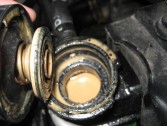
QMotor Mobile App
Find it on the App Store.

We get the inside line on the all-new QR 4.5 million McLaren P1 supercar, ahead of first deliveries this summer
The McLaren P1 was the most talked about car at the Geneva Motor Show, but now we’ve been to the McLaren Technology Centre to get under the P1's carbon fibre skin.
Without body panels, it’s amazing how tightly packed the P1’s engine bay is - just like an F1 car. P1 designer Paul Howse calls it ‘shrink-wrapped design,’ and told us that as well as being inspired by McLaren’s F1 heritage – particularly the 2008 championship-winning car – and honed in the wind tunnel, the design uses biomimickery, borrowing lines from hammerhead sharks and peregrine falcons, too.
The close-fitting bodywork means lots of heat to dissipate, which is why the heat shield behind the rear window and the exhaust finisher are made from titanium, while the rear section of the exhaust is plated with gold. Although it looks complex, the carbon fibre bodywork integrates over 200 components into just three main pieces.
P1 chief designer Dan Parry-Williams tells us that the firm evaluated two and four-wheel drive, V10 and V12 engines before deciding that its existing 3.8-litre twin-turbo engine would best meet performance and sub-200g/km of CO2 emissions targets. However, right from conception in late 2009, the firm also decided to opt for hybrid technology, including a full EV mode, which has meant that 90 per cent of the engine is new.

The hybrid system adds 190kg, but McLaren reckons it’s worth it for the performance gain. The electric motor drives the gearbox at all times, cutting the effect of turbo lag and giving an extra 180bhp and 260Nm of torque. The batteries are the densest and the motor the most powerful of any fitted to a production car. To test the system, an all-electric 12C was built, and has racked up over 60,000 road miles since 2010.
To ensure that the P1 hits the right emotional note, the car’s sound has been tuned. Two sensors, one in the intake and one in the exhaust, combine to feed sound through a symposer and into the cabin behind the driver’s head. The sound is different in all four modes, including the all-electric setting.

The Q Motor team has included some valuable tips for you which will help you pass your driving...

The engine is the most important part of the car at all, and it includes
.jpg)
Names are a large and wide world with many meanings. Our awareness of the things around us...

This guide contains a definition of traffic violations, traffic points system, classification of...
Comments